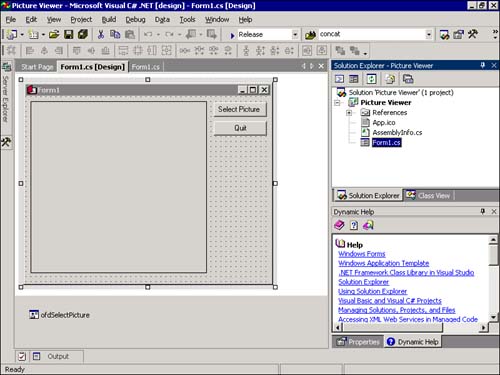Getting Help
Although C# was designed to be as intuitive as possible, you'll find that you occasionally need assistance in performing a task. It doesn't matter how much you know, C# is so complex and contains so many features that you'll have to use Help sometimes. This is particularly true when writing C# code; you won't always remember the command you need or the syntax of the command. Fortunately, C# includes a comprehensive Help feature.
To access Help from within the design environment, press F1. Generally speaking, when you press F1, C# shows you a help topic directly related to what you're doing. This is known as context-sensitive help, and when it works, it works well. For example, you can display help for any C# syntax or keyword (functions, objects, methods , properties, and so on) when writing C# code by typing the word into the code editor, positioning the cursor anywhere within the word (including before the first letter or after the last), and pressing F1. You can also get to help from the Help menu on the menu bar.
 | C#'s Help won't be displayed if your program is in Run mode when you press F1. Instead, the help for your application will appear ”if you've created Help. |
Help displays topics directly within the design environment instead of in a separate window. This is a new feature of .NET. Personally, I think this method is considerably inferior to the old style of Visual Studio having Help float above the design environment. When Help is displayed within the design environment, you can't necessarily see the code, form, or other object with which you're working. To make Help float above the design environment, choose Options from the Tools menu to display the Options dialog box, click Help in the Tree view on the left, and select External Help.
C# includes a Help feature called Dynamic Help. To display the Dynamic Help window, choose Dynamic Help from the Help menu. The Dynamic Help window shows Help links related to what it is you're working on (see Figure 2.24). For instance, if you select a form, the contents of the Dynamic Help window show you Help links related to forms. If you click a text box, the contents of the Dynamic Help window adjust to show you Help links related to text boxes. This is an interesting feature, and you may find it valuable .
Figure 2.24. Dynamic Help gives you a list of Help links related to the task you're performing.

| Top |
EAN: 2147483647
Pages: 253